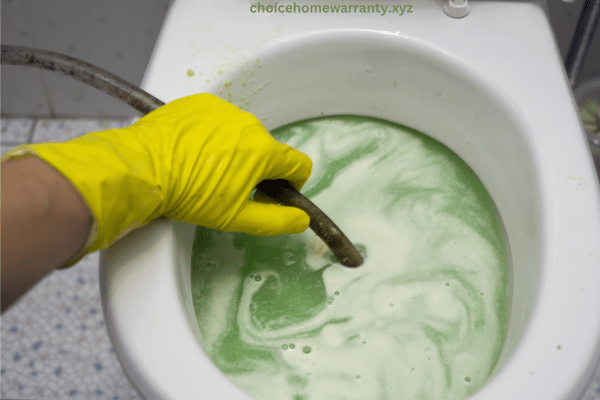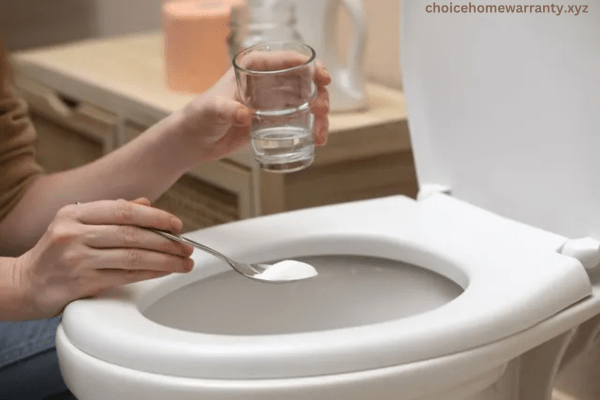Imagine you’re a host to an elegant dinner party when the unimaginable happens – a clogged toilet. Worse still, there’s no plunger in sight! But fear not, it’s possible to fix a clogged toilet without a plunger using a few simple household items. You might be amazed how everyday implements could turn around such an embarrassing dilemma with as much effectiveness as the humble plunger!
For instance, did you know that hot (not boiling) water mixed with dish soap can act as your unexpected bathroom savior? Pour a generous squirt of dish soap into the bowl followed by about half a gallon of very warm water and watch the magic happen! Let it sit for 20 minutes while the soapy mixture cuts through the blockage. Add some patience into this mix and voila, your predicament is solved seamlessly without any fancy plumbing tools. Much like using drain cleaners or vinegar-baking soda solutions, discretion and safety are of the essence here too; but more on these pro tips later!
Understanding the Causes
To effectively fix a clogged toilet without a plunger, it’s essential to grasp the different causes behind the blockage. The obstruction could be due to excessive usage of toilet paper, foreign objects being flushed down, or more intricate plumbing issues. Identifying the root cause is pivotal as it forms the initial step towards devising an effective solution and resolving the problem successfully.
Essential Tools for the Job
Before we delve into the techniques to fix a clogged toilet without a plunger, it’s essential to get acquainted with the tools that can be employed for this task. Having the right equipment at your disposal is half the battle won. These could range from everyday household items that you might not have thought can come in handy, to specialized tools designed specifically for such tasks. It’s all about using what’s available smartly and efficiently.
Method 1: Hot Water and Dish Soap
Hot water and dish soap can be used as an effective solution to fix a clogged toilet without a plunger. This handy hack involves heating up a gallon of water (not boiling), and then adding a few squirts of dish soap into the toilet bowl. After letting it sit for about 20 minutes, the combination of hot water and dish soap works to break down the clog, allowing it to flush away easily. This is a simple yet efficient method that requires minimal effort and resources.
Method 2: Baking Soda and Vinegar
If you find yourself with a clogged toilet and no plunger in sight, do not worry. You can easily fix the issue using common household items – baking soda and vinegar. These elements cause a chemical reaction that can effectively dislodge the blockage in your toilet. Simply pour a cup of baking soda into the clogged toilet followed by two cups of vinegar. The fizzing action will help break down the obstruction, leaving your toilet functioning properly again.
Method 3: Wire Hanger Technique
The Wire Hanger Technique is an effective way to fix a clogged toilet without using a plunger. This simple yet innovative method involves straightening out a wire hanger and wrapping one end with a cloth to prevent any damage to the porcelain. Then, gently maneuver the wire into the toilet drain, attempting to dislodge the clog by moving it around. The flexibility of the wire hanger often allows it to reach clogs that are beyond the reach of traditional plungers, making this technique a potential lifesaver in certain situations.
Method 4: Wet/Dry Vacuum
A Wet Dry Vacuum can be an incredibly useful tool for fix a clogged toilet without a plunger. The vacuum’s unique ability to handle both solid and liquid waste makes it optimal for this task. Instead of using a traditional plunger, which can often be messy and inefficient, the Wet Dry Vacuum can directly suction out the clog, saving time and reducing mess. It’s an innovative solution that simplifies an otherwise frustrating household problem.

Prevention Tips
When it comes to preventing a clogged toilet, it’s beneficial to know some tips on how to fix the issue without needing a plunger. Firstly, avoid flushing down anything other than toilet paper and human waste. Items like baby wipes, cotton balls, or feminine hygiene products can easily cause blockages. Secondly, if you find your toilet is clogged, try using hot water and dish soap. The heat from the water can break up the obstruction while the soap lubricates the passage for easier removal of the blockage. Regularly cleaning your toilet bowl can also help prevent build-ups that lead to clogs.
What Not to Do
When attempting to fix a clogged toilet without the use of a plunger, it’s crucial to avoid common mistakes that can potentially worsen the situation. Some individuals tend to use excessive force or inappropriate tools in an attempt to dislodge the blockage, which may damage the toilet and lead to costly repairs. Overuse of chemical drain cleaners can also be harmful as they could erode the plumbing system over time. Therefore, understanding what not to do is equally important as knowing what should be done when facing a clogged toilet.
The Importance of Timely Action
The importance of taking timely action cannot be understated, especially when it comes to fix a clogged toilet without a plunger. Waiting too long can exacerbate the situation, making it more difficult to resolve and possibly leading to further damage or undesirable outcomes such as water overflow. By acting promptly, one can utilize various methods like using hot water and dish soap, a wire hanger or even a toilet brush to clear the blockage. This not only ensures that the toilet is functional again in a short period but also helps maintain its overall condition and longevity.
Identifying the Problem: Types of Toilet Clogs
Identifying the problem is the first step when dealing with a clogged toilet. There are different types of toilet clogs, some may be caused by an excess of toilet paper or non-flushable materials blocking the drain, while others could be due to issues deep within the plumbing system such as tree roots invading sewer lines. Once identified, it’s possible to fix a clogged toilet even without a plunger. Various methods can be employed from using hot water and dish soap, a wire hanger or even baking soda and vinegar. It’s all about understanding the issue at hand and applying the right solution.
Safety Precautions When Unclogging Toilets
When it comes to unclogging toilets, safety should be your top priority. Always wear gloves and eye protection to avoid coming into contact with harmful bacteria or harsh cleaning chemicals. Make sure the area is well-ventilated if you’re using strong chemical drain cleaners. If you don’t have a plunger available, there are other methods you can try such as using a toilet brush or creating a DIY drain cleaner from household items like baking soda and vinegar. Always remember to never pour boiling water directly into the toilet bowl; it can crack the porcelain and cause serious damage.

Conclusion
Fix a clogged toilet without a plunger is not only possible but can also be quite straightforward when you know the right steps. From using dish soap and hot water to employing a wire hanger or even using a wet vacuum, there are various methods available that are effective in unclogging a toilet. By carefully following the tips outlined in this article, you can effectively deal with such an issue without needing professional help. However, remember that if the problem persists or becomes recurrent, it might be time to call in a plumber to avoid further damage. Don’t let a clogged toilet ruin your day – equip yourself with these practical solutions and take action!
FAQs Fix a Clogged Toilet Without a Plunger
Can I use boiling water instead of hot water in Method 1?
Explaining the risks and benefits of using boiling water.
How often should I use preventive measures?
Guiding in establishing a maintenance routine.
Are there any risks associated with the wire hanger technique?
Addressing safety concerns and potential risks.
Can I combine multiple methods for better results?
Advising on the judicious combination of methods.
What should I do if none of the methods work?
Suggesting when it’s time to call in professional help.
